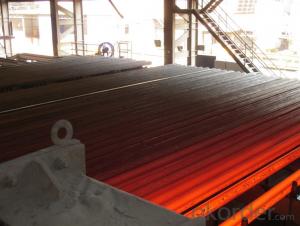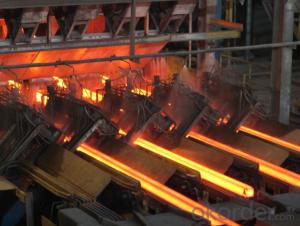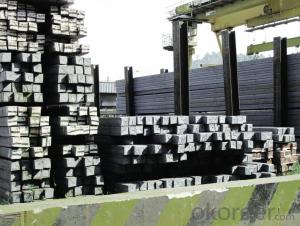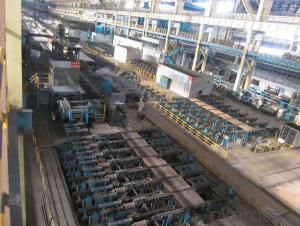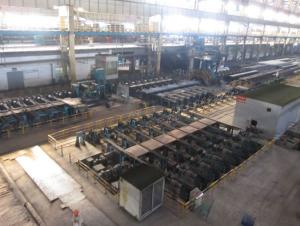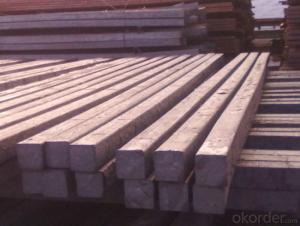Hot Rolled Square Steel Billet 3SP Standard 85mm
- Loading Port:
- Shanghai
- Payment Terms:
- TT OR LC
- Min Order Qty:
- 2000 m.t.
- Supply Capability:
- 10000 m.t./month
OKorder Service Pledge
OKorder Financial Service
You Might Also Like
Structure of Hot Rolled Square Steel Billet 3SP Standard 85mm

Description of Hot Rolled Square Steel Billet 3SP Standard 85mm
PPGI is made by cold rolled steel sheet and galvanized steel sheets as baseplate, through the surface pretreatment (degreasing, cleaning, chemical conversion processing), coated by the method of continuous coatings (roller coating method),
and after roasting and cooling. Zinc coating: Z60, Z80, Z100, Z120, Z180, Z275, G30, G60, G90
Alu-zinc coating: AZ60, AZ80, AZ100, AZ120, AZ180, G30, G60, G90
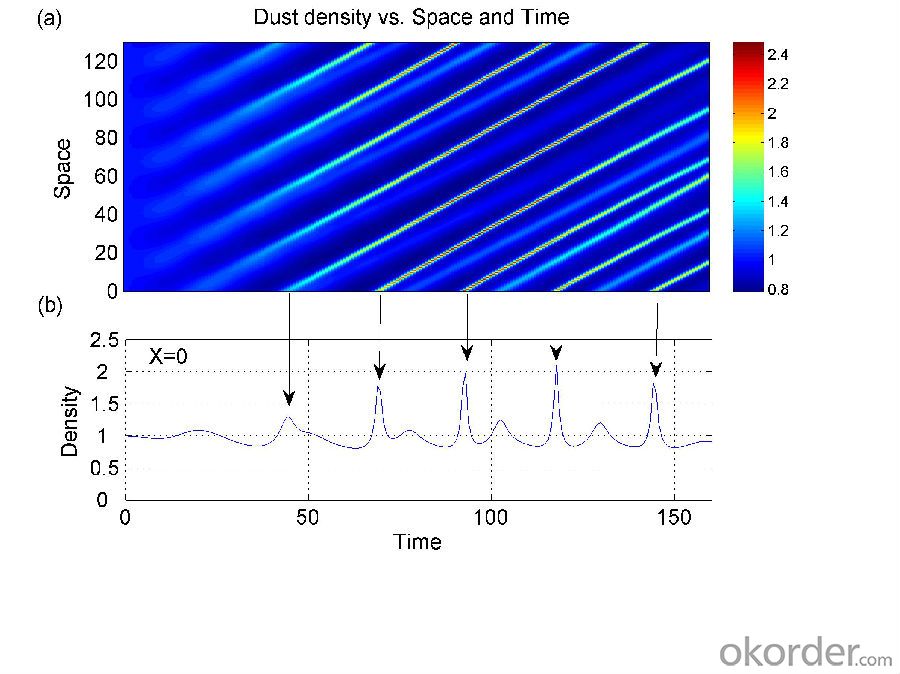
Main Feature of Hot Rolled Square Steel Billet 3SP Standard 85mm
1) Excellent corrosion resistance: The zinc layer provides a good protection of Pre-painted Galvanizeed Steel Sheet.
2) High heat resistance: The reflective surface of the material aids in efficiently reflecting the sunlight away and in turn reducing the amount of heat transmitted. The thermal reflectivity converts into energy savings.
3) Aesthetics: Pre-Painted Galvanized steel sheet is available in plethora of patterns and multiple sizes as per the requirements that given by our customers.
4) Versatility: can be used in the various areas.Standard seaworthy export packing: 3 layers of packing, inside is kraft paper, water plastic film is in the middle and outside GI steel sheet to be covered by steel strips with lock, with inner coil sleeve.
Applications of Hot Rolled Square Steel Billet 3SP Standard 85mm
1) Automotive bodies: filters, fuel tanks, etc.
2) Construction materials: roofings, welding pipes,
3) Electric and electronic appliances: computer cans, etc.
4) Steel cans: containers, etc.
5) Steel furniture: washing machines, refrigerators, microwaves, etc.
6) Drums
7) Office equipment: printer, recorders, etc.
8) Motors and transformers

Specifications of Hot Rolled Square Steel Billet 3SP Standard 85mm
| Classified symbol | Yield Point Minimum N/mm2 | Tensile Strength Minimum | Elongation Minimum % | Application | ||||
| N/mm2 | Nominal Thickness mm (t) | |||||||
| JIS | Yogic | 0.25-0.4 | 0.4-0.6 | 0.6-1.0 | 1.0-1.6 | |||
| G3312 | specification | |||||||
| CGCC | CGCC | -205 | -270 | -20 | -21 | -24 | -24 | Commercial |
| CGCD | CGCD | --- | 270 | --- | 27 | 31 | 32 | Drawing |
| --- | CG340 | 245 | 340 | 20 | 20 | 20 | 20 | Structural |
| CGC400 | CG400 | 295 | 400 | 16 | 17 | 18 | 18 | Structural |
| CGC440 | CG440 | 335 | 440 | 14 | 15 | 16 | 18 | Structural |
| CGC490 | CG490 | 365 | 490 | 12 | 13 | 14 | 16 | Structural |
| CGC570 | CG570 | 560 | 570 | --- | --- | --- | --- | Structural |
| ASTM Designation | Yield Point Minimum | Tensile Strength Minimum | Elongation Minimum % | Application | Q/BQB 445-2004(China standard) | ASM A653/A653M | JISG 3312 | |
| ksi(MPa) | ksi(MPa) | TDC51D+Z | (CS TYPE A+Z) | CGCC | ||||
| A653(M)-99 CS TYPE A,B,C | --- | --- | --- | Commercial | TDC52D+Z | CGCD | ||
| A653(M)-99 FS | --- | --- | --- | Lock Forming | TS250GD+Z | (G250+Z) | - | |
| A653(M)-99 DS | --- | --- | --- | Drawing | TS300GS+Z | (G300+Z) | CGC 400 | |
| A653(M)-99 SS Grade33(230) | 33(230) | 45(310) | 20 | Structural | TS350GD+Z | (G350+Z) | CGC490 | |
| A653(M)-99 SS Grade37(255) | 37(255) | 52(360) | 18 | Structural | TS550GD+Z | (G550+Z) | CGC570 | |
| A653(M)-99 SS Grade40(275) | 40(275) | 55(380) | 16 | Structural | ||||
| A653(M)-99 SS Grade50(345) | 50(345) | 65(450) | 12 | Structural | ||||
| A653(M)-99 SS Grade80(550) | 80(550) | 82(570) | --- | Structural | ||||
FAQ of Hot Rolled Square Steel Billet 3SP Standard 85mm
We have organized several common questions for our clients,may help you sincerely:
1. How Can I Visit There?
Our company is located in Tianjin City, China, near Beijing. You can fly to Tianjin Airport Directly. All our clients, from home or aboard, are warmly welcome to visit us!
2. How Can I Get Some Sample?
We are honored to offer you sample.
3. Why choose CNBM?
1, ISO, BV, CE, SGS approved.
2, Competitive price and quality.
3, Efficient service team online for 24 hours.
4, Smooth production ability(50000tons/month) .
5, quick delivery and standard exporting package.
6, Flexible payment with T/T, L/C, Paypal, Kunlun bank, etc .
- Q:How do steel billets compare to other forms of raw steel material?
- Steel billets are a preferred form of raw steel material due to their consistent shape and size, making them easier to handle and process. Compared to other forms like ingots or slabs, billets offer higher purity, improved mechanical properties, and better surface quality, making them ideal for various industrial applications.
- Q:What are the environmental impacts of manufacturing steel billets?
- The manufacturing of steel billets has significant environmental impacts due to the extraction and processing of raw materials, energy consumption, and waste generation. 1. Raw material extraction: The primary raw materials used in steel billet production are iron ore, coal, and limestone. Extracting these resources often involves mining, which can lead to deforestation, habitat destruction, soil erosion, and water pollution. Additionally, the extraction of iron ore requires large amounts of water, which can strain local water supplies. 2. Energy consumption: Steel billet production requires high temperatures, typically achieved through the combustion of fossil fuels such as coal and natural gas. This process is energy-intensive and contributes to greenhouse gas emissions, including carbon dioxide (CO2) and nitrogen oxides (NOx), which are major contributors to climate change and air pollution. 3. Air pollution: The combustion of fossil fuels in steel production also releases particulate matter (PM), sulfur dioxide (SO2), and other pollutants into the air. These emissions can have detrimental effects on human health, causing respiratory problems and contributing to the formation of smog. 4. Water pollution: Steel manufacturing generates wastewater containing various chemicals and heavy metals. If not properly managed, these pollutants can contaminate water bodies, harming aquatic ecosystems and posing risks to human health. Additionally, the cooling of steel production equipment often requires large amounts of water, leading to water scarcity in some areas. 5. Waste generation: Steel production generates significant amounts of waste, including slag, dust, and sludge. These by-products can contain toxic substances and require careful handling and disposal to prevent soil and water contamination. To mitigate these environmental impacts, various measures can be implemented. These include adopting cleaner production technologies, improving energy efficiency, promoting recycling and reuse of materials, implementing effective waste management practices, and investing in renewable energy sources. Additionally, companies can work towards reducing their overall carbon footprint by implementing carbon capture and storage technologies or transitioning to low-carbon energy sources such as electric arc furnaces powered by renewable energy. Furthermore, government regulations and international agreements can play a crucial role in enforcing environmental standards and promoting sustainable practices in the steel manufacturing industry.
- Q:The form of carbon in carbon steels
- The solubility of carbon content when the iron carbon alloy than in the iron when the excess carbon can be in the form of carbide iron or elemental state (graphite) in alloy, which can form a series of carbide, Fe3C (cementite, 6.69%C) is a metastable phase, it is a compound complex structure gap. Graphite is a stable phase of iron carbon alloy with simple six - party structure. Fe3C has the potential to break down into iron and graphite stable phases, but the process is extremely slow at room temperature.
- Q:What is the role of steel billets in the manufacturing of agricultural machinery?
- The manufacturing process of agricultural machinery relies heavily on steel billets, which are semi-finished steel products cast into a rectangular shape. These billets serve as the raw material for various components and parts. The utilization of steel billets presents numerous advantages in the production of agricultural machinery. Firstly, steel's exceptional strength and durability make it an ideal material for heavy-duty machinery that operates under harsh conditions. By starting the manufacturing process with steel billets, the final products acquire the necessary strength and durability to withstand the demands of agricultural activities. Moreover, steel billets offer versatility in design and fabrication. Agricultural machinery requires components of different shapes and sizes, and steel billets can be easily molded and machined to meet these requirements. This flexibility allows manufacturers to produce complex parts that are crucial for the efficient operation of agricultural machinery. Additionally, steel billets ensure consistent and reliable quality. The manufacturing process of steel billets adheres to strict quality control measures, ensuring uniformity and compliance with industry standards. This consistency in quality translates into reliable performance and longevity of agricultural machinery, reducing the need for frequent repairs or replacements. Furthermore, steel billets possess excellent resistance to corrosion and wear, which is vital for agricultural machinery exposed to various environmental elements. Using steel billets guarantees that the final products can endure exposure to moisture, chemicals, and abrasive materials commonly encountered in agricultural settings. To sum up, the strength, durability, versatility, consistent quality, and resistance to corrosion and wear make steel billets indispensable in the manufacturing of agricultural machinery. By employing steel billets as the raw material, manufacturers can produce agricultural machinery that meets the demanding requirements of the industry, ensuring reliable and efficient performance in various farming applications.
- Q:What is the role of steel billets in the manufacturing of construction cranes?
- In the manufacturing process of construction cranes, steel billets play a vital role as they are the raw materials used to produce various crane components. These billets are essentially partially finished steel products that are shaped and sized into rectangles or squares. A primary purpose of steel billets in crane manufacturing is the production of structural members like beams, columns, and braces. These components provide the necessary strength and stability to support the crane's weight and the loads it carries. Steel billets are chosen for their high strength and durability, enabling the crane to withstand heavy loads and adverse working conditions. Furthermore, steel billets are utilized to manufacture the crane's boom, jib, and lifting mechanisms. These parts experience significant stress and forces during crane operation, and the superior mechanical properties of steel billets make them ideal for ensuring the crane's structural integrity and longevity. Additionally, steel billets are used in the fabrication of counterweights for the crane. Counterweights are crucial for balancing the load being lifted and preventing the crane from tipping over. By using steel billets, manufacturers can create counterweights that are sufficiently heavy to counterbalance the loads without compromising the overall stability and safety of the crane. Moreover, steel billets are often employed in the production of other crane components such as pins, bolts, and connectors. These small yet essential parts contribute to the overall performance and functionality of the crane, ensuring smooth operation and structural integrity. In summary, steel billets act as the fundamental building blocks for the manufacturing of construction cranes, providing the necessary strength, durability, and stability required for these robust machines. Without steel billets, it would be nearly impossible to produce cranes capable of lifting heavy loads and withstanding the demanding conditions of construction sites.
- Q:What are the specifications for alloy steel billets used in the aerospace industry?
- The specifications for alloy steel billets used in the aerospace industry can vary depending on the specific application and requirements. However, there are certain general specifications that are commonly followed. Firstly, the alloy steel billets used in the aerospace industry must meet stringent material standards such as the Aerospace Material Specification (AMS) and the International Organization for Standardization (ISO) standards. These standards ensure the material's mechanical properties, chemical composition, and overall quality meet the demanding requirements of the aerospace industry. In terms of mechanical properties, the alloy steel billets should possess high strength, excellent toughness, and good fatigue resistance. These properties are essential to withstand the extreme conditions and stress experienced by aircraft components during their operation. Additionally, the chemical composition of the alloy steel billets must be carefully controlled to ensure the desired alloying elements are present in the appropriate ratios. Common alloying elements used in aerospace grade steels include chromium, molybdenum, nickel, and vanadium. These elements enhance the material's strength, corrosion resistance, and heat resistance. Furthermore, the alloy steel billets must undergo specific heat treatment processes to achieve the desired microstructure and mechanical properties. Heat treatments such as quenching and tempering, solution annealing, and precipitation hardening are commonly employed to optimize the material's strength, hardness, and ductility. The size and shape of the alloy steel billets also play a crucial role in their usability. They are typically manufactured in various cross-sectional shapes, including round, square, and rectangular, to cater to different aerospace component designs. The billets should be produced with precise dimensions and tight tolerances to ensure compatibility with the manufacturing processes and facilitate the production of high-quality aerospace components. Overall, the specifications for alloy steel billets used in the aerospace industry prioritize high mechanical strength, excellent toughness, strict chemical composition control, precise dimensions, and tailored heat treatment processes. These stringent requirements ensure that the alloy steel billets meet the demanding performance and safety standards required in the aerospace industry.
- Q:How do steel billets contribute to the manufacturing of telecommunications equipment?
- Steel billets play a crucial role in the manufacturing of telecommunications equipment by providing the necessary raw material for various components and structures. These billets, typically made from carbon steel, are semi-finished products that are further processed to create specific shapes and sizes required for telecommunications equipment. One of the key ways steel billets contribute to the manufacturing of telecommunications equipment is by serving as the base material for the fabrication of towers and masts. These structures are vital for the installation of antennas and satellite dishes, enabling the transmission and reception of signals for telecommunications networks. Steel billets are shaped and welded to create sturdy and durable towers that can withstand various environmental conditions. Moreover, steel billets are also used in the production of enclosures and cabinets for housing telecommunication equipment. These enclosures provide protection from external factors such as dust, moisture, and vandalism, ensuring the proper functioning and longevity of the equipment. Steel billets are formed into panels, frames, and chassis that are then assembled to create robust enclosures that can withstand harsh environments. In addition, steel billets contribute to the manufacturing of telecommunications equipment by being used in the production of cable trays and supports. These components are essential for organizing and routing cables, providing a neat and efficient infrastructure for telecommunications systems. Steel billets are rolled and formed into various shapes, such as channels and angles, to create sturdy cable trays and supports that can handle the weight and stress of multiple cables. Furthermore, steel billets are also utilized in the fabrication of connectors and brackets for telecommunications equipment. These small yet crucial components provide the necessary connections and support for different devices and modules in telecommunications systems. Steel billets are machined, drilled, and shaped into specific designs to create reliable connectors and brackets that ensure proper functionality and stability. Overall, steel billets play a vital role in the manufacturing of telecommunications equipment by providing the necessary raw material for various components and structures. Their strength, durability, and versatility make them an ideal choice for creating robust and reliable equipment that can withstand the demands of modern communication networks.
- Q:How are steel billets recycled or reused?
- Steel billets can be recycled or reused in several ways. One common method is through the process of melting and casting, where the billets are melted down and formed into new steel products. They can also be used as raw material in the production of other steel products, such as bars, rods, or pipes. Additionally, steel billets can be further processed and shaped into various components for construction, automotive, or manufacturing industries. This recycling and reusing of steel billets helps to conserve resources, reduce waste, and lower the environmental impact of steel production.
- Q:What are the challenges faced by the steel billet industry?
- The steel billet industry faces several challenges, including fluctuating raw material costs, intense competition from alternative materials, and the need for continuous technological advancements to remain efficient and sustainable. Additionally, market demand volatility, trade barriers, and regulatory compliance are significant challenges that impact the industry's growth and profitability.
- Q:How are steel billets stored?
- To safeguard steel billets from corrosion and other harm, they are commonly stored in a controlled environment. The approach to storage varies based on billet size, quantity, and the specific requirements of the steel producer. One frequently employed method involves horizontally stacking the billets on a flat surface, such as a concrete floor or specialized steel racks. The billets are arranged in rows and columns, leaving sufficient space for easy access and inspection. To ward off corrosion, the billets are typically coated with a protective layer, such as oil or rust inhibitors, before being stored. Furthermore, the storage area may be equipped with dehumidifiers or climate control systems to maintain optimal humidity levels and prevent moisture-related damage. For larger quantities, vertical storage in specialized racks or bins is an option. This allows for efficient space utilization and facilitates handling with the aid of machinery like cranes and forklifts. These vertical storage systems are designed to distribute the weight of the billets evenly, thus preventing deformation or damage. Regardless of the chosen storage method, regular inspection is crucial to identify any signs of damage or deterioration, such as rust, cracks, or other defects that may impact the steel's quality. Proper documentation and inventory management are also essential for efficient retrieval and use of the billets. In summary, the storage of steel billets prioritizes their protection and preservation. By adhering to appropriate storage practices, steel manufacturers can uphold the billets' quality and ensure their suitability for subsequent manufacturing processes.
1. Manufacturer Overview |
|
|---|---|
| Location | |
| Year Established | |
| Annual Output Value | |
| Main Markets | |
| Company Certifications | |
2. Manufacturer Certificates |
|
|---|---|
| a) Certification Name | |
| Range | |
| Reference | |
| Validity Period | |
3. Manufacturer Capability |
|
|---|---|
| a)Trade Capacity | |
| Nearest Port | |
| Export Percentage | |
| No.of Employees in Trade Department | |
| Language Spoken: | |
| b)Factory Information | |
| Factory Size: | |
| No. of Production Lines | |
| Contract Manufacturing | |
| Product Price Range | |
Send your message to us
Hot Rolled Square Steel Billet 3SP Standard 85mm
- Loading Port:
- Shanghai
- Payment Terms:
- TT OR LC
- Min Order Qty:
- 2000 m.t.
- Supply Capability:
- 10000 m.t./month
OKorder Service Pledge
OKorder Financial Service
Similar products
New products
Hot products
Related keywords
